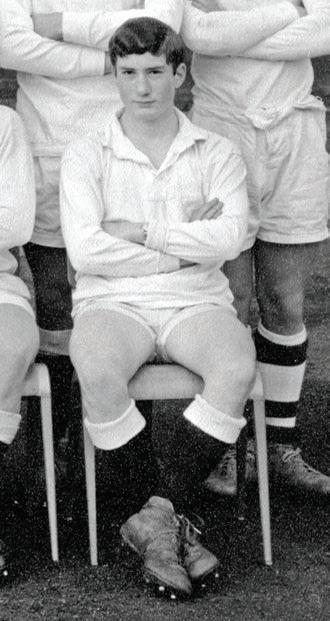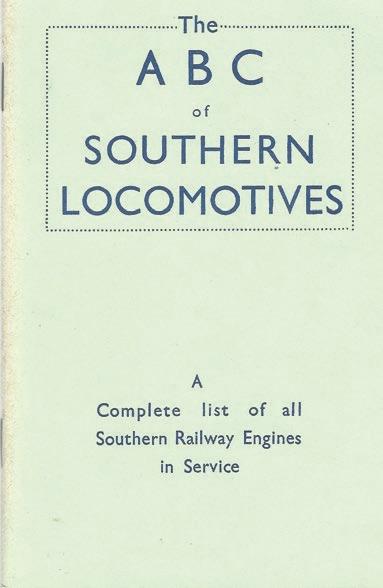
24 minute read
Briefings
Pauline Trainspotting
From London Review of Books Vol. 43 No. 1 · 7 January 2021 The Railway Hobby by Ian Jack
Pauline Pair
On a wet and windy Saturday in October 2020 a few regulars of the Ian Allan (1935-39) Book and Model Shop gathered inside the premises for the last time. The shop – on Lower Marsh, behind Waterloo Station – would soon be a memory, like many things to do with the railway hobby. Stocked with books as well as models, Lower Marsh offered both forms of railway worship – textual and idolatrous – and in the most fitting location, within the squeal and scrape of the trains arriving and departing at Waterloo. It was at that station in 1942 that Ian Allan, then a young clerk in the offices of the Southern Railway, invented – or, more accurately, enabled – the hobby that became known as trainspotting. It made him a fortune, and popularised an affectionate interest in railways matched by no other country.
Allan was sent to St Paul’s in London, where as a 15-year-old recruit to the Officers’ Training Corps he lost a leg in a camping accident. His subsequent failure to pass the School Certificate exams ended his hopes of taking up a traffic apprenticeship with the Southern Railway, the first step on the road to higher management, so he became a clerk in the publicity department instead.
By 1955, the Ian Allan Locospotters’ Club had 230,000 members, and Allan was publishing lists of almost every mechanical moving object (I’m not sure about tractors) that could be seen on land, sea and air, devoting ABC booklets to British Liners, British Tugs, British Warships, British Airliners, British Buses and Trolleybuses, sometimes narrowing the field to sub-groups such as London Transport, Clyde Pleasure Steamers and the Battleships of World War One. There were specialist magazines – Trains Illustrated was one – as well as more ambitious books that had narratives rather than lists. Ian Allan died in 2015, a day before his 93rd birthday. Allan was sent to St Paul’s in London, where as a 15-year-old recruit to the Officers’ Training Corps he lost a leg in a camping accident.
Peter Judge (1930-33) was one of the best bowlers to have played for St Paul’s taking 84 wickets in the 1933 season.
He also headed the school batting averages that year. He was good enough to play for Middlesex and Glamorgan over 14 years but he was no batsman, at least at first class level. He holds the record for the fastest pair (two noughts – a pair of spectacles) in cricket history. Coming in at a Number 11 against the touring Indians at Cardiff Arms Park in 1946 he was out first ball to complete Glamorgan’s first innings. The Indians enforced the follow on and, with little time remaining in the game, Judge stayed in the middle to open with his captain Johnny Clay. The usual ten-minute break between innings was even ignored and then Judge was instantly out first ball again.

Pauline Pews
Luke Hughes (1969-74) describes the furniture in the new School Chapel
Architecture, apart from that of monuments, has little function until there is a table to sit at or a chair to sit on. An unfurnished interior is just an empty space. Furniture articulates and, with luck, embellishes that space; it gives it meaning and enables it to be capable of being inhabited. Conversely, inappropriate furniture can dramatically diminish a building, not only aesthetically, but also for those that use or manage it.

p The Mercers’ motto, ‘Honor Deo’ is carved across the front of the altar. Photos from Kate East. Individual pieces also convey stories – about people, places, buildings, events. As well as being symbolic, they are the tactile elements of a building that directly connect across time and space to other hands, other bodies. St Paul’s has, with its numerous previous buildings, rather lost many of those connections.
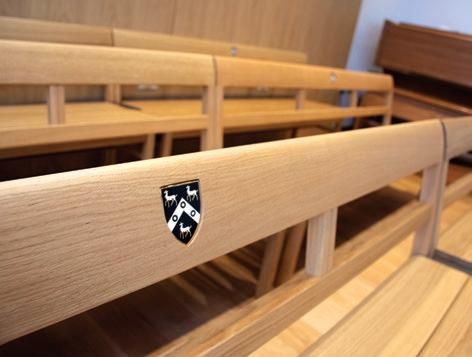
The new chapel is part of a multipurpose area for large assemblies presenting an adjoining dedicated sanctuary area, capable of being re-arranged for different types of ecumenical worship (collegiate or eucharistic, with or without choir). The furniture designs are intended to be understated while still speaking of their purpose – namely to support appropriate liturgy and to offer some dignity to ritual. In the brief given to me by the Chaplain, Rev Matthew Knox, ‘the furniture should be a focal point, enabling both the drawing in and the raising upwards’. Quite so. A table for breaking bread in a chapel is not what you expect to find in a library or a dining hall, so there is a deliberate nod to the symbolism of a numinous space, using generous sections and shadows articulated by deep chamfers to bring out the character of the wood in a sculptural way.
The furniture, in European oak, comprises an altar or Holy table, lectern, credence table, and a set of stacking pews picked out with enamelled crests of the school arms.
The altar carries on its front panel the three rings of the Trinity, from Colet’s family and the school crests but these are more closely entwined, as is common in Trinitarian interpretation. The school motto, ‘fide et literis’ is carved on the lectern; the Mercers’ motto, ‘Honor Deo’ is carved across the front of the altar and the words ‘non ministrari, sed ministrare’ (not to be served but to serve), from Matthew 20:28, are carved on the credence table.
It also includes two handsome ‘presiding’ chairs from the rebuilding of the school in the City during the 1820s, two remarkable hundred year-old survivals from the third era of school buildings. It is surprising how little tactile fabric still remains of the school’s heritage over half a millennium (by comparison, say, to Eton, Westminster or Harrow) but these chairs tell their own story and it feels wholly appropriate they have found a new purpose and relevance.
We are grateful to Alan Rind (1954-59) for his generous donation which funded the furnishing of the chapel.
Pauline Shutdown Pauline Prologue
Chris Kraushar (1953-58) alerted Atrium to a term (or part of it) in the early 1950s when Colet Court was closed. He wrote, ‘the difficulties caused by school closures have reminded me of my time at Colet Court. One boy, Charles Foxworthy-Windsor (1953-55) had contracted polio, so the school was closed.
There were of course no computers or mobile devices, no email or other methods of communication that we take for granted today. Throughout the term the teachers posted out lessons and homework to each pupil. The homework was posted back, marked and returned by post. There was simply no thought that education should suffer as a result of the closure, and it did not. Of course there were no school sports, and other social contact was discouraged for a time in case the infection had spread more widely. Otherwise life went on as normal. Adults were not considered to be at risk so went about their usual business, and the world at large was unaffected.’
Mike Drinkwater (1954-58) remembers that ‘Foxy’ had the bed next to him when boarding at Colet Court and he recalls them both being ill – Mike merely with flu but ‘Foxy’ with polio.
There was some disruption in the Summer term with the Swimming Sports Day cancelled, although Francis Neate (1953-58) remembers a full cricket season including a match against St Paul’s Girls’ School with his sister playing for the opposition. It seems the Colet Court ‘closure’ was during the autumn of 1952 – with the ‘Coletine’ magazine of spring 1953 having no record of rugby being played in the Autumn term and yet the Spring term football and boxing matches are given full coverage.
‘Foxy’ was a boarder in High House at St Paul’s. His terrible misfortune continued as he was killed in an air crash in 1955 with Alec Harbord (Master 1928-67) writing in The Pauline in 1955, ‘In August we heard of the shocking disaster over Bulgaria, when a plane flying to Israel was shot down. (Editor: Tim Cunis (1955-60) advises me that speculation at the time was that it was by the Russians fearing the plane was spying). Charles Foxworthy-Windsor was on board; he was flying out to spend some weeks in the sun, which it was hoped, would strengthen the muscles still impaired by the polio, which he contracted while at Colet Court. He was a cheerful and sociable member of the House and his death at the age of 15 is tragic’.
With thanks to Robin Wootton (1950-55)
To Jack Strawson, (Chemistry Master 1947-75) and scoutmaster in charge of Troop 3 – in the manner of Chaucer’s Prologue.
And eke a Scoutere, worthy man, was there, That had atop a croppe of redde hair. A hat of brown, that had a wyde brim That was to keep the wette rain off him. A whistle had he to control his boyes With which he oftentimes made muchel noise And he was known to all the companie As he yclept was by his scouts – Jackie.
1955 plane crash over Bulgaria.

Pauline Protestor Pauline Gallantry

p Meenal Viz at Downing Street.
Nishant Joshi (2001-06) graduated in medicine in 2014. He works as a doctor, and early in the pandemic he and his wife, Meenal (also a doctor) launched a successful legal challenge to safeguard healthcare workers.
The BBC reported, “a couple working on the NHS front line say their legal action has led to major changes in how staff are advised to use personal protective equipment (PPE).
Doctors Nishant Joshi and Meenal Viz were concerned over the use of PPE as the coronavirus pandemic took hold. Their ‘landmark case’ sparked changes, such as doctors no longer being asked to reuse masks. Both parties brought the judicial review to a close before it reached court, with Dr Joshi and Dr Viz saying both sides were satisfied appropriate changes had been made.
The couple’s campaign was motivated by the death of pregnant nurse Mary Agyapong, who contracted COVID-19 and died at the Luton and Dunstable Hospital on 12 April.
Dr Viz, who at the time was expecting the couple's first child, protested outside Downing Street during the first national lockdown.
The couple said, “Once a detailed enquiry is completed it is likely that the PPE ‘omnishambles’ will be remembered as a national scandal.”
John Dunkin (1964-69) has alerted Atrium to the gallantry of Tony Jones (1936-41).
The Battle of Arnhem in 1944 involved a number of Paulines. Among its commanders were Field Marshal Sir Bernard Montgomery (1902-06) and Major General ‘Roy’ Urquhart (1914-19). Another was a sapper Lieutenant attached to the Guards Armoured Division, later Major General Anthony George Clifford ‘Tony’ Jones of the Royal Engineers. He was awarded an MC for preventing the demolition of the vital Nijmegen Bridge.
In his Daily Telegraph obituary in 1999 his Corps Commander, Lieutenant General Sir Brian Horrocks is quoted as writing: ‘Perhaps the bravest of all these brave men was Lieutenant Jones, a young sapper officer who ran on foot behind the leading tanks, cutting the wires and removing the demolition charges’.
The obituary also mentions that in his younger days he was a vigorous front row forward for the Old Paulines, the Army, and Combined Services and for Middlesex, winners of the County Championship in 1951.
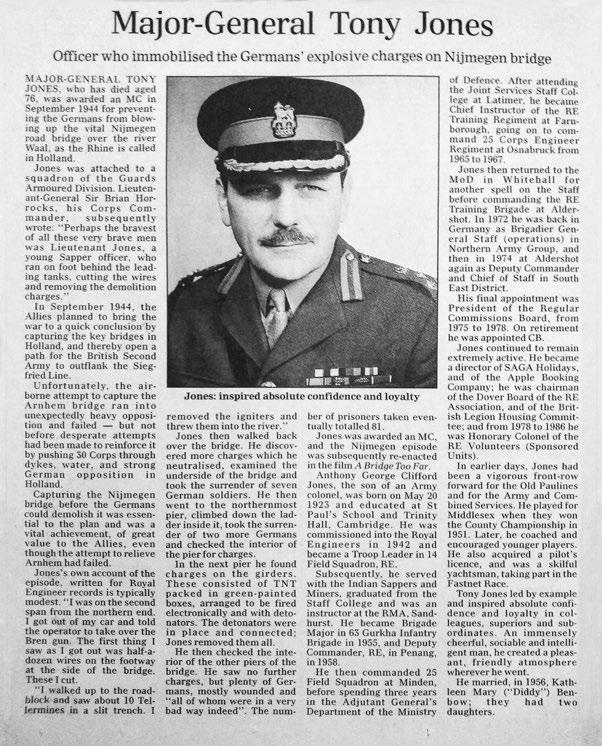
Pauline Poetry Pauline Awards
Kintsugi: Jazz Poems for Musicians Alive and Dead
Kintsugi is the debut poetry collection from writer and musician Ammar Kalia (2007-12). A multi-sensory project, Kintsugi is 13 poems written for, about and in dialogue with jazz musicians both past and very much present, accompanied by an album of original drum compositions interwoven with Ammar’s own reading of his work.

“Instrumental music has always spoken to me,” Ammar says. “This project was borne from a decade of listening to and playing jazz music, and the more I began to write professionally, the more these words started bubbling up through me, speaking via the collective weight of all that beautiful, improvisatory work to make their own poetic statements.”
The result is a clutch of poems that sit in dialogue and in tension with each other, just as instrumentalists fluctuate between harmony and frictive movement in a musical setting. From the angular assertions of “Aromanticism”, a poem for Moses Sumney, to the forlorn aggression of “Someday my prince will come”, for Miles Davis, and the biographical meandering of “Sphere”, for Thelonious Monk, the verses give a visual and visceral afterlife to these musicians’ work – one seen through the lens of Ammar’s own experiences.
Recorded at his family home in Hounslow, where Ammar first learned to play the drums at the age of 6, producer and engineer Matteo Galesi set up a portable studio, collaborating with Ammar over the course of a day to document 45 minutes of rhythmic language and texture on which to set his words.
You can find more information at: ammarkalia.bandcamp.com

Sir Mene Pangalos
Sir Mene Pangalos (1980-85) has been awarded a knighthood for his services to UK science.
Mene is responsible for BioPharmaceutical R&D at AstraZeneca from discovery through to late-stage development covering Cardiovascular, Renal, Metabolism, Respiratory, Inflammation, Autoimmune, Microbial Science and Neuroscience areas. He has led the partnership with Oxford University in developing the COVID-19 vaccine.
Since joining AstraZeneca in 2010, Mene has led the transformation of R&D productivity through the development and implementation of the “5R” framework resulting in a greater than four-fold increase in success rates compared to industry averages. In parallel, he has championed an open approach to working with academic and other external partners, changing the nature of academic-industry collaboration.
Mene holds honorary doctorates from Glasgow University and Imperial College, London, is a fellow of the Academy of Medical Sciences, the Royal Society of Biology and Clare Hall, University of Cambridge. He has sat on the Council of the MRC, co-chairs the UK Life Sciences Council Expert Group on Innovation, Clinical Research and Data and is a member of the Life Sciences Industrial Strategy Implementation Board. He is also on the Boards of The Francis
Crick Institute, The Judge Business School, Cambridge University and Dizal Pharma. Mene was awarded the 2019 Prix Galien Medal, Greece for his scientific research and named Executive of the Year at the 2019 Scrip Awards.
Sir Terence Etherton (1965-68) will sit as a cross-bencher in the House of Lords as the Lord Etherton of Marylebone.
Commenting on the announcement of the peerage, the current Lord Chief Justice, Lord Burnett of Maldon, said: 'Sir Terence has made an outstanding contribution to the nation as a judge, developing the law in critical areas and bringing about lasting improvements to the administration of justice. This will provide Sir Terence with the opportunity to continue to provide service to the public though his contribution to the House of Lords as he retires from the judiciary.'

Sir Terence Etherton
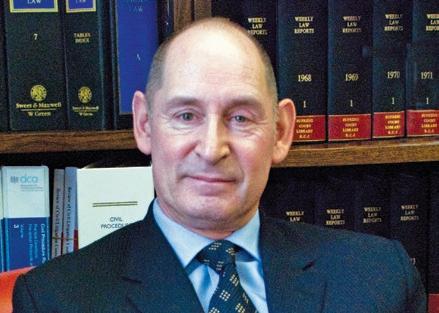
Dean Godson (1975-79) has been made a life peer and will sit as the Lord Godson of Thorney Island.
He has been Director of Policy Exchange since 2013 where he has worked since 2005. He has also been the Leader Writer for The Daily Telegraph and Deputy Editor of The Spectator when Boris Johnson was Editor.
Broadcaster Iain Dale described Policy Exchange as “the pre-eminent think tank in the Westminster village”, noting that, “Dean Godson, who has been the Director of Policy Exchange since 2013, has skilfully led Policy Exchange through three different Conservative administrations in a way that other think tanks can only marvel at. The softly-spoken Godson is often thought of as an ideological right winger, yet his pragmatism has enabled Policy Exchange to reach new heights of influence, with dozens of its alumni now sitting on the Conservative benches in Parliament.”
Dean Godson
John Clark (1959-63) has received The Cross of St Augustine for Services to the Anglican Communion for an outstanding and selfless contribution to the life and witness of churches of the Anglican Communion, especially in the Middle East and specifically Iran, over 50 years.
John’s citation included, “for over 50 years John Clark has supported the mission and ministry of Anglican churches in the Middle East – in the region as a missionary (1970s), as a desk officer (1979-87) and then Communications Director (1987-92) for the Church Missionary Society, as the Partnership for World Mission Secretary (1992-2000) and through decades of volunteering his time and talents as a trustee on the Board of several charities. He served on successive Anglican Communion Commissions for Mission (1989-2005), never seeking the limelight but skilfully navigating tensions to deliver the final report (often having drafted much of it). He was the Archbishops’ Council’s first Director for Mission and Public Affairs. In chairing the Friends of the Diocese of Iran and the Diocese of Iran Trust Fund (both since 1994) and the Jerusalem & East Mission Trust (since 2008) as well on JMECA (since 1980) he has consistently demonstrated the tireless, level-headed, solutionorientated approach that has long characterised his outstanding contribution. John’s commitment to and support for Middle East Christians goes well beyond the Anglican Communion, making him an exceptional, if unofficial, ambassador for the positive contribution the Communion makes to the life of the Church.”

p The Cross of St Augustine was founded by Archbishop Michael Ramsey and first awarded in February 1965. It is a circular medallion bearing a replica of the 9th century Cross of Canterbury, infilled with blue enamel.
Other awards:
Alan Rind (1954-59) has received a CVO for his work as a trustee of the College of St George.
Jonty Claypole (1989-95) has been awarded a MBE for services to the Creation of Culture in Quarantine Virtual Festival of Arts during COVID-19.
Alan Maryon-Davis (1956-62)
has been awarded an MBE for services to Public Health.
Pauline Books

Jonty Claypole (1989-94) Words Fail Us – In Defence Of Disfluency
Jonty Claypole (1989-94) was bullied at school because of his stutter and spent fifteen years of his life in and out of extreme speech therapy. From sessions with child psychologists to lengthy stuttering boot camps and exposure therapies, he tried everything until finally being told the words he had always feared: 'We can't cure your stutter.' Those words started him on a journey towards not only making peace with his stammer but also learning to use it to his advantage. He is now Head of Arts at the BBC.
In Words Fail Us Jonty argues that our obsession with fluency could be hindering, rather than helping, our creativity, authenticity and persuasiveness. Exploring other speech conditions, such as aphasia and Tourette's, and telling the stories of the ‘creatively disfluent’ – from Lewis Carroll to Kendrick Lamar – he explains why it is time to stop making sense, get tongue tied and embrace the life-changing power of inarticulacy.

The Black Death of 1348-9 is the most catastrophic event and worst pandemic in recorded history. Mark Bailey’s (High Master 2011-20) After the Black Death offers a major reinterpretation of its immediate impact and longerterm consequences in England.
After the Black Death studies how the government reacted to the crisis, and how communities adapted in its wake. It places the pandemic within the wider context of extreme weather and epidemiological events, the institutional framework of markets and serfdom, and the role of law in reducing risks and conditioning behaviour, drawing upon recent research into climate and disease and manorial and government sources. The government’s response to the Black Death is reconsidered in order to cast new light on the Little Divergence (whereby economic performance in north western Europe began to move decisively ahead of the rest of the continent) and the Peasant’s Revolt of 1381. By 1400, the effect of plague had worked through the economy and society, having wide-ranging implications. After the Black Death rescues the end of the fourteenth century from a little-understood paradox between plague and revolt, and elevates it to a critical period of profound and irreversible change in English and global history.

London’s West End, 1800-1914 is the first ever history of the area which has enthralled millions. The area from the Strand to Oxford Street came to stand for sensation and vulgarity but also the promotion of high culture.
The West End produced shows and fashions whose impact rippled outwards around the globe. During the nineteenth century, an area that serviced the needs of the aristocracy was opened up to a wider public whilst retaining the imprint of luxury and prestige. Rohan McWilliam (1973-78) explores the emergence of restaurants, grand hotels, concert halls, department stores, sites of curiosity and the sex industry. It is the first of a two-volume work. The second will cover the period from 1914 to COVID shutting down the West End for the first time in its history.


Simon Carne (1969-73) I Learned to Write…and to Love Public Speaking
Simon Carne (1969-73) has published a web-book (free to access) called I Learned to Write … and to Love Public Speaking. It is a story about learning to write. Not as a 5-year-old, forming letters and words but as a twenty-fiveyear old business consultant, a thirty- five year-old writing in the Financial Times and a fifty-five-year old teaching in business school.
Simon explains: “I had a lot of fun creating the website and I’ve done my level best to ensure that readers can have at least as much fun reading it. The website is punctuated with links to many articles, news items and videos (not of me!) containing thoughts that reinforce the narrative. Videos on the site include content from Jerry Seinfeld, Greta Thunberg, Rachel from Friends, Tony Blair and a dance coach who prised his way onto the site through sheer force of personality.”
The site is not just for entertainment: it is also a helpful practical tool for people who want advice on writing or on public speaking.
Luke Hughes (1969-74) Furniture In Architecture – The Work Of Luke Hughes
Through an introduction to the studio and 25 case studies, Aidan Walker explores the Arts and Crafts tradition and examines the philosophy and work of Luke Hughes (1969-74).
The book sheds light on how to balance modern manufacturing technologies with abiding craft values, rendering the small furniture workshop a relevant and profitable proposition even when fulfilling large-scale commissions. This fascinating survey defines the elements of successful design and addresses the meaning of craft and craftsmanship in the digital age.

John Shneerson (1959-65) MCC: More than a Cricket Club. Real Tennis and other sports at Lord’s
John Shneerson (1959-65) studied medicine and was a consultant respiratory physician at Papworth Hospital in Cambridge from 1980, later specialising in sleep medicine as well. John has continued to play sport ever since leaving school and has written two books on real tennis.
His new book looks at how and why MCC, the world’s most famous cricket club, came to play and excel at so many other sports. Lawn tennis, lacrosse, hockey, and baseball are all “lost” sports at Lord’s but real tennis and squash are flourishing. Their story connects closely with cricket at Lord`s but the equilibrium between them and cricket constantly changes. This account probes into the past, weighs up the present, and peers into the future.
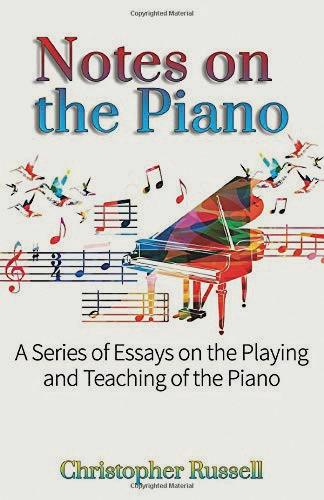
Christopher Gray (1979-83) Notes on the Piano
Christopher Gray (1979-83) is a music teacher and has taught the piano in the Kew, Richmond area for the last twenty-seven years.
His book Notes on the Piano by Christopher Russell (his stage and pen name) has just been published in paperback as well as in e-book form on Amazon. Writing in Piano Professional, Murray McLachlan, head of keyboard at Chetham’s School of Music, described Christopher’s book as touching “on vital issues that are of constant relevance to all piano students, teachers and players”.

Richard Hamilton (1978-1983) Tangier – From the Romans to the Rolling Stones
Richard Hamilton (1978-1983) is a broadcast journalist for the BBC World Service and an author. His first degree was in Greek and Philosophy at Bristol University.
He qualified as a commercial solicitor but had an early mid-life crisis and retrained as a journalist. He has a post-graduate degree in journalism from the London College of Printing and a Masters degree in African Studies from SOAS. He has worked for the BBC since 1995 and was their correspondent in Madagascar, Cape Town and Morocco. In 2011 his first book “The Last Storytellers: Tales from the Heart of Morocco” was published. “Tangier: From the Romans to the Rolling Stones” is a quirky portrait of this Moroccan city as seen through the eyes of writers, musicians and artists including Samuel Pepys OP, Henri Matisse, William Burroughs, Jack Kerouac and the founder of the Rolling Stones, Brian Jones. Richard lives in Acton with his wife Caroline and their two children, plays golf for the Old Pauline golf society and is wondering what to write next.

John Matlin (1956-61) Smoking Gun
The story of newspaperman, David Driscoll who was introduced in “Truth to Power” by John Matlin (1956-61) continues. In the late 1940s, Driscoll is tempted by an offer to save The Durham Monitor, a newspaper heading for bankruptcy. Vanity drives him to leave an important job in Washington DC and head to North Carolina. There he finds he has been lied to by the banker who tempted him with the challenge. He meets the great and good of the state, in particular tobacco baron, Jeremiah Burns. As Driscoll peels away an onion of power and corruption, he places himself and his family in danger but he is determined to bring the guilty to justice.
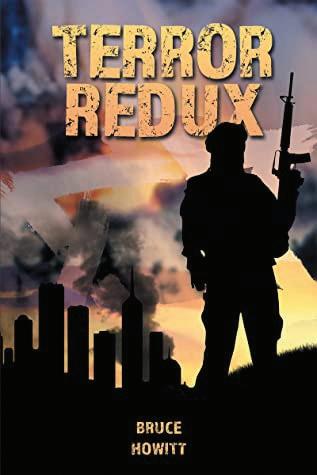
Bruce Howitt (1952-56) Terror Redux
Bruce Howitt’s (1952-56) first novel The End of Terror was published in November 2019. His second novel Terror Redux is out. After school, Bruce emigrated to Canada attending McGill University. Following a successful business career, he semiretired in 2015 to focus on his writing and his family.
Terror Redux is the account of how Israel has destroyed the Middle Eastern arm of Hezbollah. It has regrouped in South America and allied with the drug cartels. Ari Lazarus in the course of his secret agency’s hunt for Hezbollah leaders uncovers a terrifying plot to bring carnage to the United States. Rogue elements in the Chinese Politburo enlist the aid of Hezbollah to carry out massive terror attacks in the heart of six US cities. Ari Lazarus and Israeli Special Forces join together with US Special Forces and SEAL Team 6 and thwart the Chinese plot. Their mission is to end the Hezbollah and cartel reign of terror.

Bernard O’Keeffe (Master 1994-2017) Terror Redux
Bernard O’Keeffe worked in advertising before becoming a teacher. He taught at St Paul’s (Master 1994-2017). He has published two novels – No Regrets (2013) and 10 Things To Do Before You Leave School (2019). The Final Round, the first in the DI Garibaldi series, is to be published by Muswell Press in 2021.
On the morning after Boat Race Day, a man’s body is found in a nature reserve beside the Thames. He has been viciously stabbed, his tongue cut out, and an Oxford college scarf stuffed in his mouth. The body is identified as that of Nick Bellamy, last seen at the charity quiz organised by his Oxford contemporary, the popular newsreader Melissa Matthews. Enter DI Garibaldi, whose first task is to look into Bellamy’s contemporaries from Balfour College. In particular, the surprise ‘final round’ of questions at this year’s charity quiz in which guests were invited to guess whether allegations about Melissa Matthews and her Oxford friends are true. These allegations range from plagiarism and shoplifting to sextortion and murder.

